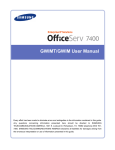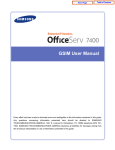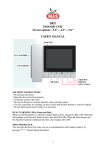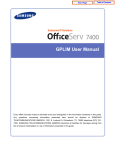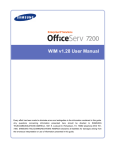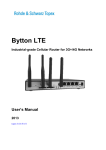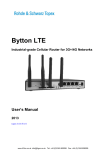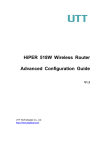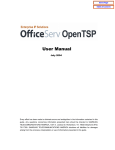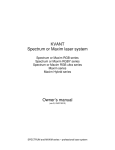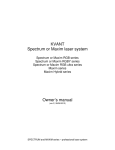Download OfficeServ 7400-GWIM User Manual
Transcript
Home Page Table of Contents 7400 GWIM User Manual Every effort has been made to eliminate errors and ambiguities in the information contained in this guide. Any questions concerning information presented here should be directed to SAMSUNG TELECOMMUNICATIONS AMERICA, 1301 E. Lookout Dr. Richardson, TX. 75082 telephone (972) 7617300. SAMSUNG TELECOMMUNICATIONS AMERICA disclaims all liabilities for damages arising from the erroneous interpretation or use of information presented in this guide. Home Page Table of Contents Samsung Telecommunications Publication Information SAMSUNG TELECOMMUNICATIONS AMERICA reserves the right without prior notice to revise information in this publication for any reason. SAMSUNG TELECOMMUNICATIONS AMERICA also reserves the right without prior notice to make changes in design or components of equipment as engineering and manufacturing may warrant. Copyright 2006 Samsung Telecommunications America All rights reserved. No part of this manual may be reproduced in any form or by any means—graphic, electronic or mechanical, including recording, taping, photocopying or information retrieval systems— without express written permission of the publisher of this material. Trademarks is a trademark of SAMSUNG Telecommunications America, L.P. WINDOWS 95/98/XP/2000 are trademarks of Microsoft Corporation. PRINTED IN USA Home Page Table of Contents INTRODUCTION Purpose This document introduces the OfficeServ 7400 Data Server, an application module of the OfficeServ 7400, and describes procedures for installing and using the software. Document Content and Organization This document consists of three chapters, an abbreviation, which are summarized as follows: CHAPTER 1. Overview of OfficeServ 7400 GWIM This chapter briefly introduces the OfficeServ 7400 GWIM. CHAPTER 2. Installing OfficeServ 7400 GWIM This chapter describes the installation procedure and login procedure. CHAPTER 3. Using OfficeServ 7400 GWIM This chapter describes how to use the menus of the OfficeServ 7400 GWIM. ABBREVIATIONS Abbreviations frequently used in this document are described. I Home Page Table of Contents Conventions The following types of paragraphs contain special information that must be carefully read and thoroughly understood. Such information may or may not be enclosed in a rectangular box, separating it from the main text, but is always preceded by an icon and/or a bold title. WARNING Provides information or instructions that the reader should follow in order to avoid personal injury or fatality. CAUTION Provides information or instructions that the reader should follow in order to avoid a service failure or damage to the system. CHECKPOINT Provides the operator with checkpoints for stable system operation. NOTE Indicates additional information as a reference. Console Screen Output y The lined box with ‘Courier New’ font will be used to distinguish between the main content and console output screen text. y ‘Bold Courier New’ font will indicate the value entered by the operator on the console screen. II Home Page Table of Contents Reference OfficeServ 7400 General Description OfficeServ 7400 System Description introduces OfficeServ 7400 and describes the system information necessary for the understanding of this system, such as hardware configuration, specification, and functions. OfficeServ 7400 Installation Manual OfficeServ 7400 Installation Manual describes the conditions necessary for the installation of the system and how to inspect and operate the system. OfficeServ 7400 Programming Manual The OfficeServ 7400 Call Server Programming Manual describes the method of using the Man Machine Communication (MMC) program that changes system settings by using phones. Revision History EDITION DATE OF ISSUE REMARKS 00 05 2006 Initial Release III Home Page Table of Contents SAFETY CONCERNS For product safety and correct operation, the following information must be given to the operator/administrator and shall be read before the installation and operation. Symbols Caution Indication of a general caution. Restriction Indication for prohibiting an action for a product. Instruction Indication for commanding a specifically required action. IV Home Page Table of Contents Caution CAUTION For Security Note that all external administrators are allowed to access the firewall when the Remote IP is set to ‘0.0.0.0’ and Port is set to ‘0:’. When Setting IP Range The number of IPs for the ‘Local IP range’ and that for the ‘Remote IP range’ should be identical when setting PPTP VPN. For example, if the number of IPs for ‘Local IP range’ is 10 and that for ‘Remote IP range’ is 20, only 10 calls will be set. When Setting PPTP in Windows XP/2000 In Windows XP/2000, the administrator can use DHCP client. If VPN PPTP client is connected while the DHCP client is operating, errors will be found. To prevent this problem, close the DHCP client operation on the [Start] Æ [Program] Æ [Administrative Tools] Æ [Services] menu of the Windows PPTP client installed. When Changing Network Interface Note that all IP sessions in working are disconnected for a while if network interface (i.e., IP, Gateway, and Subnet Mask) is changed and finally applied while operating a router. When Using a Web Browser Use Microsoft Internet Explorer(version 6.0 or higher) as the web browser for the maintenance of GWIM. Other web browsers are not supported. V Home Page Table of Contents When Using Dynamic IPs of DHCP, PPPoE, and VDSL When a dynamic IP is used, the public information of ‘Port Forward’ and ‘Static NAPT’ is not automatically changed. Therefore, ‘Fixed IPs should be used for the VoIP related services that the setups of ‘Port Forward’ and ‘Static NAPT’ menus are required. In addition, the ‘Fixed IP’ are used for the VPN services that the setups of WAN IP addresses are needed. When Changing DB If the DB is changed in OfficeServ 7400 GWIM, the system restarts. When Using a Private Key The private key is provided with the package. The private key allows accessing SSH from the outside. Thus, only trusted administrators should use the key. When Deleting Internet Temporary Files If GWIM package is upgraded, Internet temporary files should be deleted. Select [Internet Explorer] Æ [Tools] Æ [Internet Options] menu and click the [Delete Cookies] and the [Delete Files] buttons in [Internet Temporary Files] area. If these files are not deleted, the webscreen of GWIM may not be normally displayed. VI Home Page TABLE OF CONTENTS INTRODUCTION 1 Purpose .......................................................................................................................... I Document Content and Organization.............................................................................. I Conventions................................................................................................................... II Console Screen Output ................................................................................................. II Reference ..................................................................................................................... III Revision History............................................................................................................ III SAFETY CONCERNS IV Symbols ........................................................................................................................IV Caution ..........................................................................................................................V CHAPTER 1. Overview of OfficeServ 7400 GWIM 1 Introduction to OfficeServ 7400 ........................................................................................ 1 Introduction to OfficeServ 7400 GWIM ............................................................................. 2 CHAPTER 2. Installing OfficeServ 7400 GWIM 5 Installing.............................................................................................................................. 5 Getting Started.................................................................................................................... 7 CHAPTER 3. Using OfficeServ 7400 GWIM 8 Network Menu ..................................................................................................................... 9 Network ....................................................................................................................... 10 NLB.............................................................................................................................. 23 Utility............................................................................................................................ 26 Firewall Menu.................................................................................................................... 28 NAT.............................................................................................................................. 29 Filter............................................................................................................................. 33 Router................................................................................................................................ 38 General ........................................................................................................................ 39 Configuration ............................................................................................................... 40 List ............................................................................................................................... 47 VII Table of Contents Home Page Status........................................................................................................................... 54 IPMC .................................................................................................................................. 57 General ........................................................................................................................ 58 Configuration ............................................................................................................... 59 Status........................................................................................................................... 65 QoS .................................................................................................................................... 67 Group........................................................................................................................... 67 Policy ........................................................................................................................... 76 Management................................................................................................................ 77 Status................................................................................................................................. 78 Connection................................................................................................................... 79 Statistics....................................................................................................................... 80 Monitoring .................................................................................................................... 81 Services ....................................................................................................................... 82 VPN Menu.......................................................................................................................... 84 IPSec ........................................................................................................................... 85 L2TP ............................................................................................................................ 93 PPTP ........................................................................................................................... 96 Status........................................................................................................................... 98 IDS Menu ........................................................................................................................... 99 IDS Config ................................................................................................................. 100 VoIP Service Menu.......................................................................................................... 111 VoIP Service ...............................................................................................................111 SIP ALG Menu ................................................................................................................. 114 Config ........................................................................................................................ 114 Management.............................................................................................................. 116 System Menu .................................................................................................................. 117 DB Config .................................................................................................................. 118 Admin Config ............................................................................................................. 118 Log............................................................................................................................. 119 DHCP Server ............................................................................................................. 121 DHCP Relay Agent .................................................................................................... 123 Time Configuration..................................................................................................... 124 Upgrade ..................................................................................................................... 126 Appl Server ................................................................................................................ 126 Reboot ....................................................................................................................... 127 Management Menu ......................................................................................................... 128 SNMP ........................................................................................................................ 129 RMON........................................................................................................................ 132 My Info Menu................................................................................................................... 135 VIII Table of Contents Home Page ABBREVIATION 136 A ~ H.......................................................................................................................... 136 I ~ T ........................................................................................................................... 137 U ~ Z.......................................................................................................................... 138 IX Table of Contents Home Page Table of Contents CHAPTER 1. Overview of OfficeServ 7400 GWIM This chapter introduces OfficeServ 7400 system and OfficeServ 7400 GWIM. Introduction to OfficeServ 7400 The OfficeServ 7400 is a single platform that delivers the convergence of voice, data, wired and wireless communications for small and medium offices. The ‘office in a box’ solution offers TDM voice processing, voice over IP integration, wireless communications, voice mail, computer telephony integration, data router and switching functions, all in one powerful platform. With the GWIM, GPLIM and GSIM modules, the OfficeServ 7400 provides network functions such as a gigabit switching, Power Over Ethernet, high speed data routing, and network security in a single converged solution. This document describes the data and routing capabilities of OfficeServ 7400 GWIM. Structure of OfficeServ 7400 For information on the structure, features, or specifications of the OfficeServ 7400, refer to ‘OfficeServ 7400 General Description’. 1 Home Page Table of Contents Introduction to OfficeServ 7400 GWIM OfficeServ 7400 provides the following functions: Router Functions y Path management and queuing function of data packets for external WAN and internal LAN y Static and dynamic routing functions − Support of Routing Information Protocol version1(RIPv1), RIPv2, (Open Shortest Path First version2) OSPFv2, (Border Gateway Protocol 4) BGP4 routing protocol y Dynamic Host Configuration Protocol(DHCP) Point-to-Point Protocol over Ethernet(PPPoE) client function in Ethernet WAN interface y Encapsulation function of High-level Data Link Control(HDLC), PPP, and Frame Relay in Serial WAN interface y Support of IP multicast − Support of IGMPv1(Internet Group Management Protocol version1), IGMPv2 protocols − Support of Distance Vector Multicast Routing Protocol(DVMRP), (Protocol Independent Multicast-Sparse Mode) PIM-SM multicast routing protocol y Access interface function for WAN − 3-Gigabit Ethernet port: For WAN or LAN interface − 2-Serial WAN port: For data private line service by connecting to DSU or CSU, which is data line equipment(support of V.35 1 port and HSSI 1 port) y Network Load Balance(NLB) function − Function that equally distributes the load by setting several gigabit Ethernets or serial interfaces into WAN and increases the availability by automatically sharing the load with other lines when a line is not operated. Data Network Security Functions y Outbound and Inbound NAT(Network Address Translation)/PT(Protocol Translation) function − Access control for internal resources via the conversion between common IP and public IP y Firewall function − Access control from the outside by Extended Access List 2 Home Page Table of Contents y Intrusion Detection System(IDS) function − Detection and report of the access for the access control area by the access list − Recognition and notification of illegal packets by applying the basic intrusion rule for packets − Detection and block of DoS attack such as SYN Flood y Virtual Private Network VPN function − VPN gateway function based on Point-to-Point Tunneling Protocol (PPTP), Layer 2 Tunneling Protocol(L2TP), and Internet Protocol Security protocol(IPSec) − Confidentiality and integrity functions via VPN tunneling and data encryption Data Network Application Functions y Data network application functions such as NAT/PT, firewall, VPN, DHCP, and Application Level Gateway(ALG) y Use of Application Software operating in GWIM board y ALG function − Support to operate the security function and smoothly pass the VoIP packets by implementing the AIG function for signaling and media traffic y DHCP Server function − Auto-configuration of network environment for the IP equipment in another functional block of the OfficeServ 7400 system y DHCP Relay function − Function to connect the IP equipment in another functional block of the OfficeServ 7400 system to external DHCP server for the auto-configuration of network environment QoS Function y Priority queuing process for layer 3 packets and priority queuing for a specified IP y Priority queuing process for layer 4 packets and priority for RTP packets (UDP/TCP port) 3 Home Page Table of Contents Management Function y Advanced debugging functions via Telnet connection y Configuration and verification functions for the operations of GWIM functional block via a browser y Configuration and verification functions for the operations of GWIM functional block via the Simple Network Management Protocol(SNMP) y 4 Real-time Monitoring(4RMON) function y Program Upgrade − Program upgrade via Trivial File Transfer Protocol(TFTP) − Program upgrade via Hypertext Transfer Protocol(HTTP) − Program upgrade via local manager’s PC 4 Home Page Table of Contents CHAPTER 2. Installing OfficeServ 7400 GWIM This chapter describes the installation and the login procedure for OfficeServ 7400 GWIM. Software Installation OfficeServ 7400 GWIM software is pre-installed. The software package is composed of the following items described below: Package File Description Bootrom Package gwim-bootldr.img-vx.xx gwim-bootldr.img-vx.xx.sum Boot ROM program Main Package gwim-pkg-vx.xx.tar.gz Upgrade package for HTTP gwim-os..img-vx.xx ‘os’ partition upgrade package for TFTP gwim-firmware.img-vx.xx ‘Firmware’ partition upgrade package for TFTP gwim-configdb.img-vx.xx ‘configdb’ partition upgrade package for TFTP gwim-logdb.img-vx.xx ‘logdb’ partition upgrade package for TFTP gwim-flash1.img-vx.xx gwim-flash1.img-vx.xx.sum Fusing file for the first flash memory gwim-flash2.img-vx.xx gwim-flash2.img-vx.xx.sum Fusing file for the second flash memory 5 Home Page Table of Contents GWIM Installation 1. 2. 3. Insert the GWIM into an open slot in the OfficeServ 7400 cabinet. Connect a PC to port #1-3 of the GWIM module. You will need to configure your TCP/IP settings to match the corresponding default IP address of the GWIM shown in step 3. Using Internet Explorer navigate to one of the folling IP addresses to access the management interface of the GWIM. The IP initial value of the GWIM board is set as follows: y Port 1 - 10.0.0.1/24 (https://10.0.0.1) y Port 2 - 10.0.1.1/24 (https://10.0.1.1) y Port 3 - 10.0.2.1/24 (https://10.0.2.1) Caution for the Use of a Web Browser The version of the Internet Explorer should be 6.0 or higher for the maintenance of GWIM. Other web browsers are not supported. 6 Home Page Table of Contents Getting Started 1. Start Internet Explorer and enter the IP address of the GWIM into the address bar. The login window shown below will appear: 2. Log in using the administrator ID and password. The following window will appear. The GWIM menus are displayed in the upper part of the screens. Select each menu to display its submenus on the left section of the screen. For more detailed information for each menu, refer to ‘Chapter 3. Using OfficeServ 7400 GWIM’ of this document. (The default administrator name is “admin” and the default password is “root”.) 3. Click the [Logout] button on the upper section of the screen to close the connection to the GWIM system. 7 Home Page CHAPTER 3. Using OfficeServ 7400 GWIM This chapter describes how to use the menus of OfficeServ 7400 GWIM. The configuration of OfficeServ 7400 GWIM menus are as follows: 8 Table of Contents Home Page Network Menu Select the [Network menu. The submenus will be displayed in the upper left side of the window as follows: Menu Network Submenu Description Ethernet0 setup for Ethernet port P1. Ethernet1 setup for Ethernet port P2. Ethernet2 setup for Ethernet port P3. Serial0(V.35) Sets V.35 Serial ports. Serial1(HSSI) Sets HSSI Serial ports. DNS Sets domain name servers. Network Link Sets the speed and transfer method of Ethernet port. ARP Manages the addition/deletion of ARP. Network status Briefly displays the setup information on all ports. 9 Table of Contents Home Page Table of Contents Network The [Network] menu displays the five network interfaces built-in to the GWIM. This menu sets IP information, transfer speed, and transfer mode of each interface. In addition, this menu sets DNS and ARP. Note: It is recommended that your network interfaces be programmed before any other options in the GWIM. Ethernet Setup [Network] Æ [Ethernet] Select one of three Ethernet categories to display the setup window below. The selection fields are displayed depending on the method used for the corresponding interface. According to the selection of fields, different sub-setup window is displayed on the lower section of the window. The details by fields are as follows: y WAN: The following protocol types can be selected in WAN: − Static IP: Select Static IP if your Internet service account uses Fixed IP (Static) IP assignment. − PPPoE: Select PPPoE if your Internet service account uses PPP over Ethernet login protocol, such as in ADSL account. − DHCP: Select DHCP if your Internet service account uses Dynamic IP assignment, such as a Cable Modem account. y LAN: The following protocol types can be selected in LAN: − Private: Select to assign the internal network numbers based on private IP address. − Public: Select to assign the internal network numbers based on public IP address. y NONE: Select when the corresponding interface is not used. 10 Home Page Table of Contents The detailed setup in accordance with the selection of each field is as follows: WAN Æ Static IP Select the WAN-Static IP category to display the following configuration window: The details by fields are as follows: y WAN: Static IP − IP: Enter the public IP address assigned to the current network interface. − Network: Enter the netmask address of the current network interface. − Gateway: Enter the public IP address received from Internet Service Provider or the IP address of a router. − Default Gateway: Mark the check box in the Default Gateway field to select the default gateway interface when two interfaces are used for the external network. y Transparent Proxy: Proxy-ARP is used when hosts or networks are added in the Transparent Proxy field. Up to 128 Proxy-ARPs can be set in the OfficeServ 7400 system without the change of the existing network. To add entries, click the [Add] button and enter the following IP address and netmask . To delete entries, select the entry to be deleted and click the [Delete] button. y IP Alias: Is used to add up to 32 IP addresses. To add entries, click the [Add] button and enter the following IP address and netmask . To delete entries, select the entry to be deleted and click the [Delete] button. 11 Home Page Table of Contents WAN Æ PPPoE Select the WAN-PPPoE field to display the following setup window: Enter ID and Password of the ADSL account that is assigned from the ISP providing ADSL service based on dynamic IP. Check the “Option” check box in the lower section to display Method, MTU, and DNS setup window. The details by fields are as follows: y Method: Authentication Method y MTU: Input of the maximum transmission frame size(default: 1412) y DNS − Auto: Automatically receives DNS information from ISP − manual: Does not receive DNS information. 12 Home Page Table of Contents WAN Æ DHCP WAN Æ DHCP field is automatically set without a special setup field. Therefore, press the [OK] button to complete the setup. For cable modem service that requires detailed setup, mark the check box in the Option field to display the detailed setup field. To enter a vendor ID or fetch the DNS information, check [Auto]. LAN Æ Private IP Enter the IP address and the netmask value to be assigned to the network interface connected to the internal network in the IP field and the netmask field of the ‘LAN: Private IP’ table below. The IP Alias field is the same as the corresponding input field displayed when selecting WAN Æ Static IP. After the completion of the setup, click the [OK] button. 13 Home Page Table of Contents LAN Æ Public IP Enter the IP address and the netmask provided by ISP. The IP Alias and the Transparent proxy field is the same as the corresponding input field displayed when selecting WAN Æ Static IP. After the completion of the setup, click the [OK] button. NONE NONE is selected when the corresponding interface is not used. 14 Home Page Table of Contents Setup for Serial0 (V.35) and Serial1 (HSSI) Interface Type The Interface Type table is configured in the same way as that of Ethernet tablesin the previous sections. Refer to the Interface Type setup of Ethernet setup. Serial Basic The Serial Basic table sets the basic information of Serial Interface. Select one of the Serial Protocols in the Encapsulation field of this table to display the configuration window. y Serial Interface Name: Name of the current serial port y Physical Line Type: Physical line type of the current serial port y MTU: Maximum size of the packet to transfer at once y Encapsulation: Serial protocol to be used Cisco-HDLC Configuration Set the Encapsulation type as Cisco-HDLC to display the Cisco-HDLC Configuration window. Specify the value for each field, and click the [OK] button to store the configuration. y Keep-Alive Interval: Time interval to check Keep-Alive y Keep-Alive Timeout: Time to estimate the failure of Keep-Alive y IP Address: IP Address of the serial port y Gateway: Gateway IP Address(Peer Address) of the serial port y Default Gateway: Mark the check box to set this gateway to default gateway. (This item is displayed if WAN is set.) 15 Home Page Table of Contents PPP Configuration Set the Encapsulation type as PPP Protocol in the Encapsulation field to display the PPP Configuration table. Specify the value for each field, and click the [OK] button to store the configuration. y Keep-Alive Interval: Time interval to check Keep-Alive y Max Keep-Alive Count: Count of Keep-Alives to estimate as the disconnection y Authentication: Information for PPP authentication PAP, CHAP and None: Authentication method Name and Password: Administrator ID and Password y IPCP Dynamic-IP: Use of Dynamic-IP function to support IPCP y IP Address: IP Address of the serial port y Gateway: Gateway IP Address(Peer Address) of the serial port y Default Gateway: Mark the check box to set this gateway to default gateway. (This item is displayed if WAN is set.) Frame-Relay Configuration Set the Encapsulation type as Frame-Relay protocol to display the Frame-Relay Configuration table. Specify the value of each field, and click the [OK] button to store the configuration. y LMI Type: LMI type of Frame-Relay y Keep-Alive Interval: Time interval to check Keep-Alive 16 Home Page Table of Contents y N391: Cycle to request all status information. The information on all status is requested at every cycle specified in the N391 field. As usual, only Keep-Alive is exchanged. y N392: Count of Keep-Alives to estimate as the disconnection y N393: Buffer size to record success/failure of Keep-Alive. The value of N393 should be bigger than that of N392. PVC Interface Select the Frame-Relay protocol to display the PVC Interface table. Enter the value of each field and press the [Add] button to create new PVC. y DLCI: Number of DLCI(a type of network address) y IP Address: IP Address to be used by PVC y Gateway: Gateway IP Address(Peer Address) of PVC y y Default Gateway: Mark the check box to set this gateway to default gateway. (This item is displayed if WAN is set.) MTU: Maximum size of the packet to transfer at once To edit the setting of a specific PVC, select the target PVC from the list and enter the target information into each item. Click the [Edit] button. 17 Home Page Table of Contents To delete a specific PVC, mark the check box of the corresponding PVC and click the [Delete] button. Serial Interface Summary The Serial Interface Summary table briefly displays the current information of the serial port. The following figure is an example that uses Cisco-HDLC protocol and specifies the IP address as 172.16.0.2/16. 18 Home Page Table of Contents DNS Click this menu to display the following configuration window. Enter the domain name and the IP address of DNS server to the Domain name field and the DNS server field. After then, click the [OK] button to store the domain name and the IP address. Network Link The Network Link menu is used for the setup of connections, transmission speeds and transmission modes by network interfaces. y Ethernet: Logical name of each Ethernet port y Type: Type of Ethernet Cables/SFP GBIC Adapters y Negotiation: Setup of auto and force modes 19 Home Page y Speed(Mbps): Transmission bandwidth of the corresponding Ethernet interface y Duplex: Transfer mode of the corresponding Ethernet interface y MAC: MAC addresses by Ethernet interfaces Table of Contents ARP The ARP menu is used for the addition/deletion/management of the ARP information in each Ethernet interface. ARP list According to each interface, the ARP table is displayed on the ARP List window. Use the [Refresh] button and the [Delete] button to update and delete the current ARP table, respectively. y Type: ARP status y IP: IP address sent ARP y Mac: Mac address sent ARP static ARP add The Static ARP Add window is used for the addition of static ARP. y Ethernet: Ethernet to add static Mac y IP: IP address to be added y Mac: Mac to be added 20 Home Page Table of Contents ARP Age Time The ARP Age Time window is used for the setup of the cycle (at Leaset 600 sec. unit: sec.) to delete the unused ARP in the ARP table. ARP refresh The ARP Refresh window is used for the modification of the changed ARP information in the ARP table of a route or a host when the network is changed. In the host or the route with the destination IP, the Mac with the current source IP is updated into the Ethernet Mac of the OfficeServ 7400 system. y Ethernet: Ethernet to be changed y Source IP: IP to be changed y Destination IP: host or Mac to be changed 21 Home Page Network Status Select the Network Status submenu to display the Network Status window. The window displays the access network of each Ethernet interface and its information. 22 Table of Contents Home Page Table of Contents NLB Select the [Network] menu. The submenus will be displayed in the upper left side of the window as follows: The GWIM supports 5 external WAN interfaces. The system can distribute the Internet access traffic to each external interfaces by using the NLB function. For effective access traffic balancing, the system uses the ‘Weighted Round Robin’ method. The NLB menu is used for the setup of the Network Load Balancing function. Configuration [Network] Æ [NLB] Æ [Configuration] 23 Home Page Table of Contents Network Load Balance Configuration The Network Load Balance Configuration is valid when at Leaset two network interfaces are specified as the external network interface. For example, if T1 private line and ADSL line are selectively connected to Ethernet 0 Interface (eth 0) and Ethernet 1 Interface (eth 1), the higher weighted value is given to the eth 1 connected with ADSL line that its bandwidth is relatively bigger and the lower weighted value is given to the eth 0. In this way, the load balancing according to the performance of the external network line is performed. The system has the Failover function that a different internal network interface line automatically backs up when any failure occurs in some of multiple external interfaces. The details by fields are as follows: y NLB Weight: Relatively higher load is distributed in the line of the external interface side that higher numerical value is assigned. The weighted value for each external interface should be the greatest common divisor (minimum irreducible unit). Static Configuration Along with the Network Load Balance Configuration, the Static Configuration window is used to pass a specific external network interface line by separately specifying the traffic session to satisfy a specific condition. In this window, entries can be added or deleted by clicking the [Add] or the [Delete] button in the bottom of the window. 0.0.0.0 of the IP address field and all ‘0s’ of the port field indicates all IP addresses all port numbers, respectively. y Source: Source IP address, netmask and port number of transfer session y Destination: Destination IP address, netmask and port number of transfer session y Traffic distribution: Interface and protocol that transfer session passes through 24 Home Page Table of Contents − Protocol: Protocol to be applied − Gateway: External network interface that the corresponding traffic session passes through(if the default gateway is selected, the load balancing by Network Load Balance Configuration is applied.) − Backup: Backup interface to perform the failover function when any failure occurs in the external network interface line selected in the Gateway field.(For the application of load balancing, select default gateway.) The input of 0.0.0.0 in the IP address and netmask input field represents that any IP addresses are allowed as the source and the destination IP addresses. In addition, all ‘0s’ of the source port number means that any port number is allowed as the source port number. Network Load Balance Management The Network Load Balance Management window is used for starting and stopping the NLB service. y Activity: Current activity y Action: Click the [Run] button to start the NLB service. y If the OfficeServ 7400 system is restarted the NLB service will automatically return to its last state. 25 Home Page Table of Contents Utility Select the [Network] menu. The submenus will be displayed in the upper left side of the window as follows: Ping The Ping menu is used to initiate a ping test. The [Destination IP] item is used to enter the destination address of a remote host to check if communication is being established. Enter the target information into the [Destination IP] item and click the [Run] button. Then, a ping test is executed. 26 Home Page Table of Contents Only one destination IP can be tested of each time and the radio button of the IP to be tested is checked. The radil button of the destination IP on the top is default. 27 Home Page Firewall Menu Select the [Firewall] menu. The submenus will be displayed in the upper left side of the window as follows: Menu NAT Filter Submenu Description Management To select the use of NAT function Configuration To set the private IP sharing function Port Forward To set the port forwarding function Static NAT To set the static forwarding function Management To select the Filter function Configuration To set the Filtering policy Remote Access To permit or block the remote access to the system IP Filtering To block a specific IP access URL Filtering To block the web access to the specified site ICMP Redirect To block ICMP Replay of the system 28 Table of Contents Home Page Table of Contents NAT The Network Address Translation(NAT) menu is used for the assignment of a network using private IPs. Management The use of NAT is set. Setting Description Enable To enable the NAT function Disable To disable the NAT function Configuration The administrator can configure a network configured with private IPs. A private IP can be transferred to the Internet through an authenticated IP. Basic Mode This table configures a network by using the minimum value of the options required for the configuration of a private network. 29 Home Page Category WAN IP Table of Contents Description To set a general IP. Set up the connected port after selecting a dynamic IP for ADSL or Cable modem. Inside To enter a network address to configure a private network or select the range of netmask.(/: netmask, -: range, *; all) Outside To enter the network address connected to WAN or select the range of netmask.(/: netmask, -: range, *; all) Insert To select the location to insert the entered rule. Advanced Mode This table allows the administrator to select and set up a port or protocol that is not included to the basic configuration additionally. Category Description Port For only some specific ports, It is allowed to set up for the outside. Protocol Select TCP and UDP protocols. Both TCP and UDP are set up for ‘All’. The administrator can view the current status of configuration on Configuration List. 30 Home Page Table of Contents Port Forward This table allows connecting to PC, which has a private IP inside the system, from outside environment. Basic Mode: The basic mode is set up by using the minimum value of the options for port forwarding. Category Description Inside IP To set the IP to be connected from the outside. Outside To enter the network address connected to WAN or select the range of netmask.(/: netmask, -: range, *; all) WAN IP To set an authenticated IP.(/: netmask, -: range, *; all) Insert To select the location to insert the entered rule. Advanced Mode: The administrator can select and set up ports or protocols that are not included in the basic configuration additionally. 31 Home Page Category Port Table of Contents Description It is available to set up as only some specific ports are allowed to transfer to the outside. Protocol Select a TCP and UDP protocol. For ‘All’, both TCP and UDP should be set up. Configuration List displays the current setup status. Static NAT This window allows the administrator to connect the PC, which has a private IP on the internal system, to the outside. The administrator can designate the port range and the port is mapped by 1:1. Category Description Inside IP: Port To set an IP connected to the outside and a port. WAN IP: Port To set a port to be connected to the configured WAN IP. Protocol To select a protocol. Insert To select a location to insert the entered rule. 32 Home Page Table of Contents Filter The administrator can set up the filtering for the traffic forwarding through the system. Management Setting Description Enable To enable the Filter function Disable To disable the Filter function Configuration The administrator can set up the filtering policy for the packets passing through the system. Basic Mode Enter the minimum options required for packet filtering. Category Description Source IP To set the origination IP. Destination IP To set the destination IP. Target To select Allow or Deny. 33 Home Page Advanced Mode This window allows the administrator to assign additional options for packet filtering. Category Description Source IP To set the origination IP. Destination IP To set the destination IP. Port To set the port. Protocol To set the protocol. Time Set To set the time to apply the filtering rule. Insert To select a location to insert the entered rule. This table displays the current setup status. 34 Table of Contents Home Page Table of Contents Remote Access Allow or Deny remote access. Default Policy y Allow: The basic policy is ‘Allow’ and the administrator can set up the policy by using ‘Target’. y Deny: Blocks all accesses from the outside except the PC that is set up as the manager IP. y Administration IP: Enter the manager IP. Pay attention on entering the IP because all accesses may be denied. 35 Home Page IP Filtering URL Filtering Administrator can deny web access to PCs connected to the system. 36 Table of Contents Home Page Category Description Source IP To set the origination IP. Keyword To enter the keyword of the site to deny. Time Set To set the time to apply the filtering rule. ICMP Redirect Administrators can deny the INTERNET CONTROL MESSAGE PROTOCOL (ICMP) Replay packet. Select the target interface and enable the interface to apply to this table. 37 Table of Contents Home Page Table of Contents Router Select the [Router menu. The submenus will be displayed in the upper left side of the window as follows: Menu General Configuration Submenu Description Routes Displays the routing table of GWIM. Management Starts or stops RIP, OSPF, and BGP. Static Sets a static route. RIP Sets RIP. RIP Interface Sets RIP interface. OSPF Sets OSPF protocol. OSPF Interface Sets OSPF interface. BGP Sets BGP. 38 Home Page Menu List Status Submenu Table of Contents Description Access List Sets Access-list. Prefix List Sets Prefix-list. Route Map Sets Route-map. As Path List Sets BGP AS-path list. Community List Sets BGP Community-list. Key Chain Sets the key used for authentication of RIP v2. RIP Displays RIP network information. OSPF Displays OSPF neighbour information. BGP Displays the Neighbor status connected with the BGP network information. General This menu is used to start/stop RIP, OSPF, and BGP services or to retrieve the routing table of GWIM. Routes Select [General] Æ [Routes] to retrieve the routing table of GWIM. Item Type Description - C: Network directly connected to GWIM network interface - S: Static network set by a administrator - R: Path information received from another router via RIP - O: Path information received from another router via OSPF protocol - B: Path information received from another router via BGP * >: Whether to have activated routing table Network Network/Netmask information of route Entry Route information 39 Home Page Table of Contents Management Select [General] Æ [Management] to start/stop RIP, OSPF, and BGP services. Configuration This menu is used to set static route, RIP, OSPF protocol, and BGP. Static Route Select [Configuration] Æ [Static] and set a static route. After setting the target item, click the [Save] button. Enter the Static Route command. When the entered command is successfully executed, the configuration is directly applied to <Current Status> of [Router] Æ [Configuration] Æ [Static]. For example, when entering the static route command, the <Current Status> window is displayed as follows: 40 Home Page Table of Contents Help Select the argument corresponding to the ‘ip route’ or ‘no ip route’ command. Click [Argument] to display all arguments corresponding to the command.. Current Status Displays the current static table from the GWIM. Displayed information is identical to [Router] Æ [General] Æ [Routes]. Item Type Description - S: Static network ser by a administrator - *>: Whether to include activated routing table Network Network/Netmask information of route Entry Route information RIP [Configuration] Æ [RIP] Enter the RIP command. If the entered command is successfully executed, the execution result is directly applied to <Current Status> of [Router] Æ [Configuration] Æ [RIP]. Help Select the Argument corresponding to the RIP command. Clicking the [Argument] item displays all arguments corresponding to the command. 41 Home Page Table of Contents RIP Basic After selecting each item, click the [OK] button. Then, the applied value is displayed in the <Current Status> window. Displays the command configuration currently entered. RIP Interface [Configuration] Æ [RIP Interface] Select the target interface and enter the protocol configuration command directly. If the entered command is successfully executed, the execution result is directly applied to <Current Status> of [Router] Æ [Configuration] Æ [RIP Interface]. Help Select the argument corresponding to the RIP interface. Clicking the [Argument] item displays all arguments corresponding to the command. 42 Home Page Table of Contents RIP Interface Basic After selecting each item, click the [OK] button. Then, the applied value is displayed in the <Current Status> window. Displays the command configuration currently entered. OSPF [Configuration] Æ [OSPF] Select the target interface and enter the protocol configuration command directly. If the entered command is successfully executed, the execution result is directly applied to <Current Status> of [Router] Æ [Configuration] Æ [OSPF]. Help Select the argument corresponding to the OSPF command. Clicking the [Argument] item displays all arguments corresponding to the command. 43 Home Page Table of Contents OSPF Basic After selecting each item, click the [OK] button. Then, the applied value is displayed in the <Current Status> window. Displays the command configuration currently entered. OSPF Interface [Configuration] Æ [OSPF Interface] Select the target interface and enter the protocol configuration command directly. If the entered command is successfully executed, the execution result is directly applied to <Current Status> of [Router] Æ [Configuration] Æ [OSPF Interface]. Help Select the argument corresponding to the OSPF interface. Clicking the [Argument] item displays all arguments corresponding to the command. 44 Home Page Table of Contents OSPF Interface Basic After selecting each item, click the [OK] button. The applied value is displayed in the <Current Status> window. Display the command configuration currently entered. BGP Select [Configuration] Æ [BGP] and set BGP. After setting the target item and click the [Save] button. Enter the BGP configuration command directly. If the entered command is successfully executed, the execution result is directly applied to <Current Status> of [Router] Æ [Configuration] Æ [BGP]. For example, when the BGP command is entered, the <Current Status> window is displayed as follows: 45 Home Page Table of Contents Help Select the argument corresponding to the BGP command. Clicking the [Argument] item displays all arguments corresponding to the command. Select an argument from them. BGP Basic After entering each item and clicking the [OK] button, the configuration values are displayed in the <Current Status> window. Current Status Display the configuration information related with BGP of GWIM. Click the [Delete] button to delete all configuration information. 46 Home Page Table of Contents List Access List [List] Æ [Access List] Item Description ID Sets the Access-list name. Action Allows/Rejects the packet matched. Source Match Sets the match condition. Any - All packets Host - A host Network - Network range Destination If ID ranges from 100 to 199 or from 2000 to 2699, Destination Match Match can be set as well as the Source Match condition Any - All packets Host - A host Network - Network range Exact match Available when ID is set to word and when match condition is set to Network. Sets only the packets matched correctly with the prefix. If the entered command is successfully executed, the execution results are directly applied to <Current Status> of [Router] Æ [List] Æ [Access List]. For example, when Access-list is entered, the <Current Status> window is displayed as follows. 47 Home Page Table of Contents Click the [Delete] button to delete the corresponding access-list. Item Description ID Access-list name information Entry Access-list description Prefix List Select [List] Æ [Prefix List] and set Prefix-list. After setting the target item, click the [OK] button. Item Description ID Sets the prefix-list name. Seq Sets the sequence No. of the prefix-list. Action Allows/Rejects the packets matched. Prefix Match Sets the match condition. - Any: All packets - Network: network range. . If the entered command is successfully executed, the execution results are directly applied to <Current Status> of [Router] Æ [List] Æ [Prefix List]. For example, when a prefix is entered, the <Current Status> window is displayed as follows: 48 Home Page Table of Contents Prefix-list information being set in GWIM can be displayed. Click the [Delete] button to delete the entry of the selected prefix list. Click the [Delete All] button to delete all entries of the prefix list. Item Description ID Prefix-list name information Entry Prefix-list information Route-Map [List] Æ [Route-Map] Enter the target value and click the [OK] button. Item Description Name Route-map name Action Sets whether to apply set operation. Sequence Sets the sequence No. to additionally delete a route-map If the entered command is successfully executed, the execution results are directly applied to <Current Status> of [Router] Æ [List] Æ [Route-Map]. For example, when a route-map is entered, the <Current Status> window is displayed as follows: 49 Home Page Table of Contents This menu is used to view the information on the route-map set in GWIM. Item Description Name Route-map name Entry Route-map information Click the [Delete] button to delete the target route-map. Click the [Edit] button to display the window as follows. Through this window, the target Set/Match operation of the route-map can be set. Item IP Description - Address: Sets access-list or prefix-list for an IP to be matched. - Next-hop: Sets the Next-hop IP to be matched. Metric Sets the Metric to be matched. Set options are as follows: Item Description IP Sets next-hop of the BGP table. Metric Sets metric of the BGP table. Weight Sets weight of the BGP table. Community Sets community of the BGP table. 50 Home Page Item Metric-Type Table of Contents Description Sets metric type of the BGP table. - Type 1: External Type 1 - Type 2: External Type 2 Local Preference Sets local preference from BGP attribute. When the match condition is met and Action is set to Permit, the job corresponding to Set operation is performed. If the command is successfully executed, the execution result is directly applied to <Current Status>. Item Description Sequence Matches/Sets operation Sequence No. of route-map. Entry Matches/Sets operation information of route-map. Click the [Prev.] button to return to the route-map window mentioned above. Click the [Delete] button to delete the selected Match/Set operation. As Path List Select [List] Æ [As Path List] and set AS Path access-list of GWIM BGP. Enter the target value and click the [Save] button. Item ID Description Sets AS Path access-list name. 51 Home Page Item Action Table of Contents Description Decides whether to allow/reject if the BGP route information exists that meets the match condition. Match Sets normally match condition. If the entered command is successfully executed, the execution results are directly applied to <Current Status> of [Router] Æ [List] Æ [As Path List]. For example, when as path access-list is entered, the <Current Status> window is as follows: This menu is used to display the information on the as path access-list set in GWIM. Item Description ID As path access-list name Entry As path access-list information Click the [Delete] button to delete the entry of the selected as path access-list. Click the [Delete All] button to delete all as path access-list entries of the corresponding name. Community List Select [List] Æ [Community List] and set Community List of GWIM BGP. Set the target value and click the [Save] button. 52 Home Page Item ID Table of Contents Description Sets Community list name Expanded - When normally community list is set Standard - When community list with selected format is set Action Sets whether to allow/reject the community to be matched Match No-Advertise - Do not distribute path to the neighbor router No-Export - Do not distribute path to an external neighbor router Local-AS - Do not distribute path to the neighbor router of the lower AS located at BGP combination network. In other cases, set normally to community list. If the entered command is successfully executed, the execution results are directly applied to <Current Status> of [Router] Æ [List] Æ [Community List]. For example, when as path access-list is entered, the <Current Status> window is displayed as follows: Item Description ID Community list name Entry Community list information Click the [Delete] button to delete the target community-list entry. Click the [Delete All] button to delete all community-list entries of the name. 53 Home Page Table of Contents Status RIP This menu is used to display the RIP connection status and information. Item Description Network Displays network information Next Hop Next Hop address of the RIP route that sends neighbor. Metric Metric information. From Displays the address being connected. If Displays interface information. Time Update time. OSPF This menu is used to check the OSPF connection status and information with the other party’s router. Item Description Neighbor ID Neighbor ID of the other party’s router Pri Priority Status Displays the connection process. Dead Time Displays the dead time. Address Address of the other party Interface Interface connected 54 Home Page BGP This menu is used to check the BGP connection status information and BGP routing table information. Item Description BGP Router ID Current system router-ID Sets to the IP address that is the highest in the IPs set in loopback when an address or a loopback that is the highest from the IP addresses is used. Local AS Number Local AS No. set by a administrator BGP Table Version BGP table change version information BGP AS-PATH Entries Number of AS PATH Hash tables used in BGP BGP Community Number of Hash table of community attribute used in BGP Entries Total Neighbor Total sum of BGP neighbor Item Description Neighbor IP address of the neighbor router V Version No. used by neighbor AS AS No. of neighbor MsgRcvd Message number received from neighbor MsgSent Message number sent from neighbor TblVer Latest BGP database version sent from neighbor InQ Number of messages that should be received from neighbor and processed 55 Table of Contents Home Page Item Description OutQ Number of messages sent to neighbor Up/Down Displays the path time when BGP session is finished. Displays the status when BGP session is not finished. State/PfxRcd Number of BGP routes via neighbor or peer group or BGP current status Item Network Description Displays network information. Status code information s - Indicates the suppressed network. * - Indicates proper network information. h - BGP dampening is activated. > - best route i - Indicates the network entered by IBGP. Nexthop Nexthop address of the BGP route sent from neighbor Metric MED value of BGP neighbor LocalPrf Local Preference. Default is 100. Weight Weight allocated in prefix - Local route default is 32768. - The default of the sent route is 0. Path Displays the list of AS path that should be passed to go to the network corresponding to the prefix. Origin code information i - Information received by the network command e - Information received via EGP ? - Information received by redistribution 56 Table of Contents Home Page Table of Contents IPMC Select the [IPMC] menu. The submenus will be displayed in the upper left side of the window as follows: Menu General Configuration Submenu Description Mroutes Displays Multicast Routing Entry. Management Starts/Stops IPMC protocol demons. IGMP Displays or changes IGMP configuration. DVMRP Displays or changes DVMRP default configuration. DVMRP Intf Displays or changes VIF of DVMRP. PIM-SM Displays or changes PIM-SM default configuration. Status PIM-SM Intf Displays or changes VIF PIM-SM. IGMP Groups Displays IGMP Group information. DVMRP Displays DVMRP neighbor and Prune information. PIM-SM Displays PIM-SM Neighbor information. 57 Home Page Table of Contents General Mroutes This menu is used to display multicast routing entries being shown in this window. y Mroute: Multicast Routing identifier y Uptime: Time passed after starting the operation of multicast routing entry y Expires: Rest time until multicast routing entry is expired y Flags: Multicast routing feature flag. Refer to the description on the lower side y Incoming: Name of VIF to which multicast is sent y Outgoing: List of VIF where multicast is sent Management This menu is used to run or stop dvmrpd and pimd, IPMC protocol demons. <Current Status> of Management shows the current status of each demon. To change the demon status, select another status from [Action] and click the [OK] button. y Protocol: IPMC protocol y Current Status: Current IPMC protocol demon status y Action: New status of IPMC protocol demon status 58 Home Page Table of Contents Configuration IGMP This menu is used to display and change IGMP configuration. IGMP & Help IGMP commands can be entered and executed. Enter the target command into the input field and click the [OK] button. Then, the command is executed. IGMP Basic Enter new information and click the [OK] button to change the default configuration of IGMP. y Interface: Select the target IGMP interface and select All. Then, all interface configuration values are applied. y IGMP Query Interval: Cycle of sending IGMP Membership Query y Max Response Time: Maximum time of waiting a response after sending Membership Query 59 Home Page Table of Contents IGMP Interface Information This menu is used to display the IGMP interfaces. y Address: IGMP group address y Intf: IGMP interface name y Querier Address: IP address of IGMP interface that sends membership query. IP address of Designate Router(DR) y Query Interval: Cycle of sending Membership Query y Max Resp Time: Maximum time of waiting a response to Membership Query Configuration / DVMRP This menu is used to set DVMRP. DVMRP & Help Enter a command into DVMRP field and click the [OK] button to execute the command. 60 Home Page Table of Contents DVMRP Routes This menu is used to display DVMRP Route items in use. y Source Network: VIF network address to which multicast packets flow y Flags: DVMRP route feature flag. N=New, D=Direct Connected, H=Hold down y Intf: VIF name to which multicast packets flow y Neighbor: DVMRP neighbor IP address that provides information on DVMRP route y Metric: DVMRP route Metric(=distance) value y Uptime: Time passed after using the DVMRP route item y Expires: Left time until the DVMRP route item is expired DVMRP Intf This menu is used to add or set DVMRP VIF. RD Interface This menu is used to add L3 interface where an IP address is set to DVMRP VIF. Select the target interface to be added to VIF from the Interface item, enter the target value, and click the [Add] button. y Interface: Select the target L3 interface y Reject Non-pruners: Non-pruners indicate the neighbors that only support DVMRP with the previous version. Mark if this is not communicated with the DVMRP with the previous version. y Metric: Metric(=distance) value to be used for multicasting routing by VIF 61 Home Page Table of Contents DVMRP Interfaces This menu is used to display the configuration DVMRP VIF. To delete a specific VIF, check the check box on the left and click the [Delete] button. y Intf: DVMRP VIF name y Address: IP address of DVMRP VIF y Type: DVMRP VIF type. Tunnel, Point-to-Point, Broadcast y Neighbor Count: Number of neighbors connected to DVMRP VIF y Remote Address: Address of the other party in case of Tunnel or Point-to-Point type.(Peer Address) PIM-SM This menu is used to set PIM-SM. PIM-SM & Help Enter the target command into the input field of PIM-SM and click the [OK] button. 62 Home Page Table of Contents PIM-SM Basic This menu is used to set BSR and RP of PIM-SM protocol. Mark the check box on the right and enter the configuration values. Click the [OK] button to apply the values. Mark the check box of the target item and click the [Delete] button. y RP Address: When setting static RP, enter the IP address of RP y RP Candidate: When setting RP Candidate, select VIF and enter the target priority.(Low value has high priority.) y BSR Candidate: When setting BSR Candidate, select VIF and enter the target Mask Length and Priority.(High value has high priority.) BootStrap Information This menu is used to display the information on BootStrap router. 63 Home Page Table of Contents RP Information This menu is used to display the information on RP router. Click the [Delete] button to delete all RP configurations. PIM-SM Intf This menu is used to set PIM-SM VIF. RD Interface This menu is used to add PIM-SM VIF. Select the target L3 interface from the Interface item, enter the target values, and click the [Add] button to add PIM-SM VIF. y Interface: Select the target L3 interface to be added to PIM-SM VIF y Mode: Select the target PIM-SM protocol mode. Sparse, Passive y DR Priority: Enter the priority value used when selecting Designate Router (DR). (High value has high priority.) y Hello Interval: Cycle of exchanging hello packets with connected PIM-SM neighbors 64 Home Page Table of Contents PIM-SM Interfaces This menu is used to display the VIFs added to PIM-SM. To delete a VIF, click the check box on the left and click the [Delete] button. IGMP Groups This menu is used to display the information on registered IGMP group. y Group Address: IGMP group address y Intf: IGMP interface name y Uptime: Time passed after IGMP group is created y Expires: Left time until the IGMP Group information is expired y Last Reporter: Client IP address that sends the last membership report Status DVMRP This menu is used to display the DVMRP protocol status. DVMRP Neighbors This menu is used to display the information on the DVMRP neighbor whose information is exchanged. 65 Home Page y Neighbor Address: IP address of DVMRP Neighbor y Interface: VMRP VIF name y Uptime: Time passed after being connected y Expires: Left time until the Neighbor connection information is expired Table of Contents DVMRP Prune Information This menu is used to display DVMRP Prune items. y Source Address: Host Ip address that sends multicast packets y MaskLen: Mask length of DVMRP Prune y Group Address: Multicast group address y State: Flags that display the DVMRP Prune status. Refer to the description on the lower side y FCR Cnt: DVMRP Forwarding Cache count y Expires: Time passed after the DVMRP Prune information is created y ReXmit: Left time until retransmission PIM-SM This menu is used to display the neighbor list of PIM-SM protocol. y Neighbor: Neighbor IP address y Intf: IP address of VIF connected with neighbor y Uptime: Time passed after being connected with neighbor y Expires: Left time until the Neighbor connection information is expired y Ver: Version of the PIM-SM protocol used for the connection y DR Priority: Designate Router(DR) priority of neighbor y DR: Displays whether the neighbor is Designate Router(DR) 66 Home Page Table of Contents QoS Select the [QoS] menu. The submenus will be displayed in the upper left side of the window as follows: Menu Group Submenu Description Port Group Retrieves, sets, edits, or deletes a port group IP Group Retrieves, sets, edits, or deletes an IP group Filter Group Retrieves, sets, edits, or deletes a filter group Class Group Retrieves, sets, edits, or deletes a class group Policy - Sets a class for a port Management - Starts or stops the execution of a QoS and sets to execute when the system reboots. Group The [Group] menu is used to retrieve, set, edit, or delete a port group, an IP group, a filter group, or a class group. Port Group Select [Port Group] to retrieve, set, edit, or delete a port group. 67 Home Page Table of Contents Click the [Add] button in the above window to display a window from which a port group can be set. Enter the target ID and port No. and click the [Save] button. Click the [Add] button to add a port, and click the [Delete] button after marking the checkbox to delete the target port. Item ID Description Name of the port group - Should include both letters and numbers. - Group ID shall start only with letters, not numbers. - No blanks should be left in between characters. Port - Port range - Enter ‘0’ to set all ports 68 Home Page Table of Contents IP Group Select [IP Group] to retrieve, set, edit, or delete an IP group. Click the [Add] button in the above window to display a window from which an IP group can be set. Enter the target ID and port No. and click the [Save] button. Click the [Add] button to add an IP, and click the [Delete] button to delete the target IP. Item ID Description Name of the IP group - Should include both letters and numbers. - Group ID shall start only with letters, not numbers. - No blanks should be left in between characters. IP IP address /: Used for entering subnet -: Used for entering the range of IPs Enter ‘0.0.0.0/0’ to set all ports. 69 Home Page Table of Contents Filter Group Select [Filter Group] to retrieve, set, edit, or delete a filter group. If ‘dev_voip’ is registered as the filter group as shown above, the filtering rule is as follows: y ‘Source’ and ‘Destination’ items are the information set in the [Port Group] and [IP Group] menus. y All TCP packet traffics of which the internal IP is Develop_Team (192.168.0.0/24) and the connection port is VoIP(10000~20000) are filtered with a priority of ‘1’. y The filter is then associated with the class group set at the [QoS] Æ [Group] Æ [Class Group] menu. Click the [Add] button in the above window to display a window from which a filter group can be set. Set the items and select the target IP and port from the list and click the [Save] button. Filter means a configuration filtering for the values in the packet header. Values set in [QoS] Æ [Group] Æ [Port Group] and [IP Group] are used. Protocols and TOS fields can also be filtered. In addition, priority can be set for each filter and apply the filtering rule according to the priority. 70 Home Page Table of Contents Class Group Select [Class Group] to retrieve, set, edit, or delete SPQ class group and HTB class group. A class includes information on the defined filtering rule and the bandwidth that should be assigned to the filtered traffic. SPQ Class Group Click the [Add] button of the SPQ Class Group list in the <Class Group> window. Then, the window that can set SPQ class group appears. If Class Type is set to leaf, the window displayed is as follows. Set the ID and filter of leaf class and click the [OK] button. When the Class type is set to root, the window is as follows. Set the root class ID and child class and click the [OK] button. 71 Home Page Item Class Type Table of Contents Description Configuration window depends on the type of the class to be set. - root: Sets the root class. - Leaf: Sets the leaf class. High Sets the leaf class whose priority will be set to high. Middle Sets the leaf class whose priority will be set to middle. low Sets the leaf class whose priority will be set to low. Filter List Sets the filtering rule for the target traffic in the target class. SPQ SPQ queue is the simplest queuing method. The priority of the leaf class can be set to high, middle, or low. From the highest priority, service is provided. HTB Class Group Click the [Add] button of HTB Class Group List in the <HTB Class Group> window to display the window where HTB class group can be set. If the class type is root, the window is displayed as follows. Set each item and click the [OK] button. 72 Home Page Table of Contents If the class type is general, the window is displayed as follows. Set each item and click the [OK] button. If the class type is non-leaf, the window is displayed as follows. Set each item and click the [OK] button. 73 Home Page Table of Contents If the class type is leaf, the window is displayed as follows. Set each item and click the [OK] button. Item Class Type Description Configuration window depends on the type of the class to be set. - root: Sets the root class. - general: Sets the class that connects the root with the leaf classes. - non-leaf: Sets the default class. - Leaf: Sets the leaf class. 74 Home Page Item Parent ID Table of Contents Description If the target class is a child class of another class, set the parent class in the Parent ID item. Do not set the Parent ID if the target class is the root class(highest level class physically connected to the device) or if the default class(class including the bandwidth for traffics that do not belong to a filter). Priority If several classes compete to occupy leftover bandwidths or if all classes attempt to occupy excess bandwidth, set the priority so that the class with the highest priority occupies the bandwidth first. MTU The Maximum Transmit Unit(MTU) represents the maximum amount of packets that can be transmitted at a time. It is recommended that this configuration does not exceed the maximum packet size (1504 Byte) of Ethernet. If this item is not entered, the default value, ‘1500’ Byte, will be applied. Rate This is the basic bandwidth needed for setting class for an assigned bandwidth. Ceil Maximum value of assigned bandwidth. Burst Size of data that can be sent by the class. Cburst Maximum data size that can be sent at a time. Filter List Sets filtering rules for the class. Leaf Qdisc Set a desired Qdisc for the Leaf Qdisc parameter when setting the Parameter lowest level class. Scheduling Changes the bandwidth of the class based on day and hour. Parameter Click the [Add] ort [Delete] button to add or delete. Because of the attribute of QoS layer, the class to be set may be the highest class(Root Class) or the lowest class(Leaf Class). In addition the class to be set is classified into Parent class and Child class. 75 Home Page Table of Contents Policy The [Policy] menu is used for setting a class for a port. Enter the following items and click the [Save] button to select a class for a port. Item Description Device Selects a port(eth0, eth1, eth2, V.35, or HSSI) QDISC Type Selects QDISC to be applied to the port. R2Q R2Q is used as a variable for calculating the amount of Deficit Round Robin(DRR).(Bps/r2q) Root Class Class connected to the port. Select the class group from the class group list. Default Class This class defines the bandwidth for incoming traffics that are not applicable to all filtering rules. Select the class group from the class group list. 76 Home Page Management This menu is used to execute, stop, and re-execute QoS. In addition, this menu is used to execute or stop the execution of the ‘Scheduling Parameter’ set in [QoS] Æ [Group] Æ [Class Group]. 77 Table of Contents Home Page Table of Contents Status Select the [Status menu. The submenus will be displayed in the upper left side of the window as follows: Menu Connection Submenu Sessions Description Displays the information on the IP and port connected to GWIM. Statistics Devices Displays GWIM network statistics by classifying Tx and Rx of each device. Monitoring Protocols Displays GWIM network statistics of each protocol. Current Provides the GWIM network statistics in the table format in real time. History Displays the GWIM network statistics on an hourly, weekly, monthly, yearly basis. Process Displays the information on processes being operated in GWIM. Services - Displays service status in a table format by classifying various functions provided by GWIM into Security, Router, and Management. 78 Home Page Connection The [Connection] menu is used to display the GWIM session connection status. Sessions This menu is used to display the information connected to GWIM. Item Description Protocol Type of the protocol connected with session(UDP, TCP) Src IP Source IP Src Port Source port Status - UNREPLIED: Packets that are expected to be answered are received, but there is no response packet. - ASSURED: There is no response packet. (‘UNREPLIED’ is changed to ‘ASSURED’.) Dst IP Destination IP Dst Port Destination port 79 Table of Contents Home Page Table of Contents Statistics This menu is used to display GWIM network statistics of each device and protocol. Devices Select [Statistics] Æ [Devices] and display GWIM network statistics by classifying received part and transmitted part of each device. Item Description Devices Port type Bytes Total number of bytes received or transmitted Packets Total number of packets received or transmitted Errs Number of packets where an error occurs Drop Number of packets lost Fifo FIFO queue is full(FIFO Overrun) Frame Ethernet header is not met the format(Frame Alignment Error) Compressed Number of compressed packets Multicast Number of multicast packets 80 Home Page Table of Contents Protocols Select [Statistics] Æ [Protocols] and display GWIM network statistics of each protocol(Unit: Byte) Monitoring This menu is used to display GWIM network statistics in real time or display as accumulation value of a certain period. Current This menu is used to display GWIM network statistics in real time, and the data is updated every 5 seconds. 81 Home Page Table of Contents History This menu is used to display CPU use, available memory capacity, and network statistics of GWIM as the accumulation value on an hourly, weekly, monthly, and yearly. Services This menu is used to display the status of the Security, Router, and Management services provided by GWIM in a table format. If ‘Auto Start’ is set to ‘On’, the services are provided automatically while the system reboots. If ‘Activity’ is set to ‘Running’, the service is being performed. If ‘Activity’ is set to ‘Stopped’, the service stops. Security This menu is used to display the current status of the Security service provided by GWIM. 82 Home Page Table of Contents Router This menu is used to display the current status of the Router service provided by GWIM. Application This menu is used to display the current status of the Application service provided by GWIM. Management This menu is used to display the current status of the Management service provided by GWIM. 83 Home Page Table of Contents VPN Menu Select the [VPN] menu. The submenus will be displayed in the upper left side of the window as follows: Menu IPSec Submenu Description Configuration Sets up IPSec. Management Allows/Inhibits execution of IPSec. Sets whether to execute IPSec when the system reboots. L2TP Certificate Generates or deletes a certificate. Configuration Sets up L2TP. Management Allows/Inhibits execution of L2TP. Sets whether to execute L2TP when the system reboots. PPTP Configuration Management Sets up PPTP. Allows/Inhibits execution of PPTP. Sets whether to execute PPTP when the system reboots. STATUS IPSec Checks if IPSec tunnel is properly connected. L2TP/PPTP Checks if L2TP/PPTP is properly connected. Setting up VPN Client in Windows XP/2000 Setting up VPN client in MS Windows is required when IPSec and PPTP are set in the [VPN] menu in the OfficeServ 7400 Data Server. For detailed information on setting method, refer to ‘Appendix A’.. 84 Home Page Table of Contents IPSec IP Security Protocol(IPSec) provides security services in the IP layer through implementing Internet Key Exchange(IKE). The security service is categorized into two services depending on remote equipment: the services providing security tunnels between local subnet and remote subnet, and between local subnet and remote host. Even if IPSec can be set up to provide a security tunnel between local host and remote host, the GWIM board is used for a gateway, not a host. Thus, this service is not used. Since IPSec setting requires two gateways for a security tunnel, local configuration and remote configuration have the same items. IPSec Tunnel Mode OfficeServ 7400 Data Server only supports the IPSec Tunnel mode. The transport mode is not supported. In addition, if the WAN interface is used for SERIAL, IPSec is not supported. Since a SERIAL line is used for a dedicated line, IPSec is not required for the security. Config On the [IPSec] Æ [Configuration] menu, the administrator can add, delete, and search an IPSec tunnel. The menu buttons are defined as shown below: Item Description Add Creates IPSec tunnel Delete Deletes IPSec tunnel Edit Modifies IPSec tunnel data 85 Home Page Table of Contents Add Click the [Add] button from the <IPSec Connection> window to display the window below. Enter the value of each item and click the [Add] button to add an IPSec tunnel. Item Description Connection ID ID composed of certain letters(Required) IP Address External IP address(Required) Router Router IP address Subnet IP Internal IP address Subnet Mask Internal subnet mask RSA Key/ Selects host authentication method Preshared Key - RSA Key: Public key is RSA key of Local settings. Click the /Certificate [Download] button to store RSA key to your PC, and send it to other PC through a path. After RSA key of Remote settings receives file in the target PC through a path, click the [Upload] button to enter a key value. - Preshared Key: Authentication method entering password. - Certificate: its own certificate and the CA certificate that authenticates the previous certificate are used for the authentication. For Local settings, select a certificate from the certificate list.(If selecting a certificate, the Local ID of Advanced is entered automatically) For Remote settings, enter Remote ID. It is available to check the integrity of the host certificate registered to Local. If the value of the ‘Router’ item is not entered, the ‘IP address’ item of the Local settings and Remote settings will be used as the ‘Router’ item. 86 Home Page Table of Contents If the ‘Subnet IP’ item value and the ‘Subnetmask’ item value are not entered in the Remote settings, the security tunnel between local subnet and remote host will be added. Then, remote IPSec client can operate as a part of local subnet. Router Value Configuration If ‘IP Address’ of ‘Local settings’ and the network address of ‘IP Address’ of ‘Remote settings’(the result of Netmask for IP Address) are identical, enter the value of ‘IP Address’ of ‘Remote settings’ as the value for the ‘Router’ of ‘Local settings’ and enter the value of ‘IP Address’ of ‘Local settings’ as the value for ‘IP Address’ of ‘Remote settings’. Connection ID Value Configuration The value of Connection ID should be configured of alphanumerical characters and the first character should be an alphabet. (The value cannot be composed of only numbers.) Advance Click the [Advanced] button from the <IPsec Add> or <IPsec Mod> window to display the following window and it is available to set up detailed items of IPSec. 87 Home Page Item Phase1 mode Description Ike mode - main: Configures a secure channel to perform the ISAKMP exchange of phase one - aggressive: Different type of phase one, which is more simple and faster than the main mode Encryption- Supporting Algorithm Hash Algorithm 3DES-MD5, 3DES-SHA1, AES128-MD5, AES128SHA1, AES192-MD5, AES192-SHA1, AES256-MD5, AES256-SHA1 Key life time IKE Duration If Key life time is passed, the host authentication (the phase one IKE) is performed again. Phase2 Protocol Selects a packet authentication protocol - Authentication Header(AH): Allows the authentication of data transmitter - Encapsulating Security Payload(ESP): Allows the authentication and data encryption Encryption- Supporting Algorithm Hash Algorithm 3DES-MD5, 3DES-SHA1, AES128-MD5, AES128SHA1, AES192-MD5, AES192-SHA1, AES256-MD5, AES256-SHA1 Key life time The cycle of newly added key used for packet encryption by the repeated phase two IKE negotiation Advance PFS Selects whether to use a session key transfer/security Re-Key Sets whether to add a new key(whether to add a new key and negotiate again in the phase 1, 2 IKE). Negotiation Reattempt count of key exchange when key count exchange is failed on the phase 1 IKE Connection IPSec Connection Attempt - initiator: Attempting a connection - response: Attempt to receive a connection IPSec/l2tp Sets when IPSec over l2tpis is used. (Supports Window XP SP 2.) DPD Time out Effective time when the counterparty receives a DPD packet and receive packet Delay Alive check time of the counter party Action Action after Dead Peer Detect - hold: Waiting for connection - clear: No more connection 88 Table of Contents Home Page Table of Contents The aggressive mode only supports the authentication methods of Pre-shared key and Encryption Algorithm 3DES. The items use defaults and it is available to modify the value of PFS or Key lifetime for the interaction with other equipments. Management The administrator allows/inhibits executing IPSec services on the [IPSec] Æ [Management] menu. When the system is rebooted in the execution of IPSec, the IPSec service is automatically performed. Click the [OK] button on the [Create the new RSA key] item to add a new RSA (public key password method) key. Use this menu to add a new RSA key if the host authentication method of RSA key used. Click the [OK] button after selecting a device in the [External Device] items to apply the IPsec connection to the device. 89 Home Page Table of Contents Certificate The administrator can verify Issue/delete/download of CA Certificate and Host certificate, addition/delete of an external certificate and the current certificate list. The menu buttons are defined as shown below: Item Description (CA) Download CA Certificate download (CA) Delete CA Certificate delete (Ex) upload External CA Certificate upload (Ex) Delete External CA Certificate delete (Host) Add Host Certificate add (Host) Delete Host Certificate delete 90 Home Page CA Certificate Each item of the CA Certificate is defined as follows: Item Description Country name Country name(Two characters: ex. kr, cn) State name State name Locality name Local name Organization name Company name Organization unit name Organization(division) name Common name Name Email address Email Password Certificate password Confirm Password Confirming the password of certificate * Verify the certificate password when deleting CA Certificate. 91 Table of Contents Home Page External Certificate The uploaded items of an external certificate are defined as follows: Item Description CA Certificate External certificate upload Host Certificate The uploaded items of the external certificate are defined as follows: Item Description Common name Name Email address Email address Password Certificate password Confirm Password Confirming certificate password 92 Table of Contents Home Page Table of Contents L2TP The administrator can set up the security tunnel between a local subnet and remote host by using the Layer2 Tunneling Protocol(L2TP). Since it is simpler to set up than IPSec and software is provided from the Windows operating system, the administrator can apply the VPN function easily. Configuration In the [L2TP] Æ [Configuration] menu, the administrator can create/modify/delete/ retrieve the VPN tunnel data. The menu buttons are defined as follows: Item Description Add Create a PPTP administrator Delete Delete a PPTP administrator Edit Modify a PPTP administrator information Add If clicking the [Add] button on the <L2TP administrator list> window, the following window appears. Enter each item and click the [OK] button to create a L2TP administrator. 93 Home Page Item Administrator ID Table of Contents Description ID composed of certain letters Password Shared password Dynamic IP Enter dynamic IP to remote client Static IP Enter static IP to remote client(Enter IP address) Edit Click the [Edit] button from the <Administrator List> window. Then, the window below appears. Enter each item value and click the [OK] button to edit VPN tunnel data. 94 Home Page Table of Contents Management In the [L2TP] Æ [Management] menu, the administrator can allow/inhibit executing PPTP services. When the system is rebooted in the execution of L2TP, the L2TP service is automatically performed. The administrator can set up the IP range of the remote client that uses dynamic IP in the ‘Local IP range’ item, and set up the IP range of PPP demon responsible for remote client in the ‘Remote IP range’ item. The encryption method supports ‘pap’ and ‘chap’. Setting up IP Range The number of IPs for the ‘Local IP range’ and that for the ‘Remote IP range’ should be identical. For example, if the number of IPs for ‘Local IP range’ is 10 and that for ‘Remote IP range’ is 20, only 10 calls will be set. 95 Home Page Table of Contents PPTP The administrator can set up the security tunnel between a local subnet and remote host simply by using Point to Point Tunneling Protocol(PPTP). Since it is simpler to set up than IPSec and software is provided from the Windows operating system, the administrator can apply the VPN function easily. Configuration On the [PPTP] Æ [Configuration] menu, the administrator can create, modify, delete, and retrieve VPN tunnel data. The menu buttons are defined as follows: Item Description Add Create a PPTP administrator Delete Delete a PPTP administrator Edit Modify PPTP administrator information Add [Add] Æ <PPTP administrator list> 96 Home Page Item Administrator ID Table of Contents Description ID composed of certain letters Password Shared password Dynamic IP Enter dynamic IP to remote client Static IP Enter static IP to remote client(Enter IP address) Edit [Edit] Æ <Administrator List> Management In the [PPTP] Æ [Management] menu, the administrator can allow/inhibit executing PPTP services. When the system is rebooted in the execution of PPTP, the PPTP service is automatically performed. 97 Home Page Table of Contents The administrator can set up the IP range of the remote client that uses dynamic IP in the ‘Local IP range’ item, and set up the IP range of PPP demon responsible for remote client in the ‘Remote IP range’ item. The encryption method supports ‘pap’ and ‘chap’. Setting up IP Range The number of IPs for the ‘Local IP range’ and that for the ‘Remote IP range’ should be identical. For example, if the number of IPs for ‘Local IP range’ is 10 and that for ‘Remote IP range’ is 20, only 10 calls will be set. Status Check the IPSec tunnel set up in [STATUS] Æ [IPsec] to insure it is properly connected. Check the L2TP/PPTP tunnel set up in [STATUS] Æ [L2TP/PPTP] to insure it is properly connected. 98 Home Page IDS Menu If selecting the [IDS menu. The submenus will be displayed in the upper left side of the window as follows: Menu IDS Config Submenu Description Log Analysis Classifies the logs currently stored in types to verify and search the logs Configuration Sets up the rule and detection level of IDS. Rule Config Updates to new rule files. Mail Config Registers the mail server and email address of the manager. Block Config Registers IP(IP that is not checked to block module) confirming and trusting the block list registered to a block module. Management Allows or inhibits executing IDS module and block module. 99 Table of Contents Home Page Table of Contents IDS Config Log Analysis The administrator can view alerts detected in the IDS module by category. Select the desired category and click the [OK] button. Then, the following page appears. Type Category Item Description Intrusion type Analyzes logs detected by IDS rule Source IP Analyzes logs by Source IP detected at IDS Destination IP Analyzes logs of the OfficeServ 7400 external IP (eth0, eth1, eth2) detected at IDS Destination Port Analyzes logs when the destination IP of a log detected at IDS is the port of an external IP (eth0, eth1, eth2) Port Scan Analyzes the logs when the logs detected at IDS have port scan type Date - Time that log is recorded Search Log - Analyzes and retrieves logs 100 Home Page Table of Contents Intrusion Type The administrator can summarize alerts by type. If selecting the category of Intrusion Type, the following window appears: Item Rate(%) Description Monitors logs detected by IDS according to type and displays logs as a percentage(%). Num Number of logs detected by IDS according to type. Priority Risk level depending on the rules level of IDS. - high: Rule level is one day(the highest risk level) - med: Rule level is 2 or 3 days(mid level) - low: Rule level is 4 days(low level) Description Type of logs detected by IDS If clicking the unique ID of an alert, Sid displays the information on the alert. 101 Home Page Source IP The administrator can summarize alerts by the Source IP. If selecting this category, the following window appears: Item Num Description Number of logs detected by IDS according to the host(source) IP that attacks the logs Remote host Host IP that attacks logs detected at IDS Priority Risk level depending on the rules level of IDS - high: Rule level is one day(the highest risk level) - med: Rule level is 2 or 3 days(mid level) - low: Rule level is 4 days(low level) Description Type of logs detected at IDS 102 Table of Contents Home Page Table of Contents Destination IP The administrator can summarize alerts by the destination IP. If selecting this category, the following window appears: Item Num Description Number of logs detected by IDS according to attacked Destination IP Local host Attacked host IP of logs detected by IDS Priority Risk level depending on the rules level of IDS - High: Rule level is one day(the highest risk level) - Med: Rule level is 2 or 3 days(mid level) - Low: Rule level is 4 days(low level) Description Type of logs detected by IDS Destination Port The administrator can summarize alerts by destination port. If selecting this category, the following category appears: 103 Home Page Item Num Table of Contents Description Numbers of detected by IDS according to port when attacked Destination IP is a network (e.g., LAN). Port Attacked host IP of logs detected by IDS. Priority Risk level depending on the rules level of IDS - High: Rule level is one day(the highest risk level) - Med: Rule level is 2 or 3 days(mid level) - Low: Rule level is 4 days(low level) Description Type of logs detected by IDS Port Scan The administrator can summarize alerts for Port Scan. If selecting this category, the following window appears: Item Ports Description Number of TCP and UDP ports that are scanned in logs detected by IDS. Hosts Number of host that a port scanned in logs detected by IDS Remote host IP that attempts port scan Search The administrator can search by condition 104 Home Page Table of Contents If selecting the category including the desired condition, the selection box is activated. Then the administrator can select the desired condition. Set up the condition and click the [OK] button to display the desired information on the window as follows: Selecting Search Condition Since the conditions are not displayed dependently, the administrator cannot obtain a result that satisfies all conditions. Configuration This page allows the configuration required for the IDS module. The administrator can set up the network monitored by IDS, detection level, rule file to be used at the IDS module, etc. Select Device The administrator can set up a network to monitor. For IDS module, the interface is WAN and the protocol monitors only for a static network. Therefore, if the network status is in UP, the administrator can select a check box as the check box is activated. 105 Home Page Table of Contents Set Detection Level & Type The intrusion type is classified into High, Medium and Low according to the risk level. The administrator can set up the intrusion detection level as alert is generated when an intrusion exceeding the level occurs. In addition, the administrator can set up the associated operation for each level. If setting up a block, this block is associated with the block module. So, if an intrusion corresponding to the relevant level is detected, the relevant IP is blocked not to prevent to access to the system for a configured time. (Refer to ‘Block Config’) If setting up Mail, alerts are transferred when a mail is transmitted. (Refer to ‘Mail Config’) 106 Home Page Table of Contents IDS Rule Configuration This page allows setting up the rule file to be used in the IDS module. Pressing the [OK] button after selecting the desired rule activates all of the selected rule sets. By checking the check box on the top of each column, all rules in the relevant column will be selected. Click the [Default] button to select the default rules. 107 Home Page Table of Contents Rule Config The administrator can update the rule-set file used in the IDS module to the latest version. The following window shows the version of the current rule-set file and the reLeased date: Th administrator can manulally update the rule set by clicking the “Browse” button and selecting a new “Rule-Set” to upload. Mail Config Set SMTP Server IP The administrator can enter an E-Mail address to receive the SMTP Server IP and alert record. Up to 10 E-Mail addresses can be entered. 108 Home Page Table of Contents Set Time for Sending Mail The administrator can set up the time to send an email. If clicking the button in the Now category, an email is sent to the e-mail address stored above the recorded alert. Select One Time to send a mail at the relevant time. The other items are used to check if there is an alert and send to Mail at the configured time daily, weekly or monthly. SMTP Server IP Configuration If you are not receiving an email verify the SMTP Server IP or retrieve the IDS log in System Æ Log. If there is no recorded alert, an email was not sent. Block Config In this page, the administrator can view the block list applied to the block module or enter a trusted IP. Manage Blocked IP List If an intrusion is detected when the IDS module and block module are all in operation, the IP of the block that is set up at Configuration Menu according to the intrusion risk, is blocked to access to the system for an amount of time. Manage Blocked IP List shows the list of IP that the access is blocked. 109 Home Page Table of Contents Manage Trusted IP List The administrator can register a trusted IP. Enter the IP and netmask and click the [OK] button to register. Check the IP list that is already registered and click the [Delete] button to delete the list. The IP registered in this page is not blocked even in the abnormal status defined at IDS. Management In this page, the administrator can set up the operation of the IDS module and block module. Item Status Description - Running: Status that the module is in operation - Stopped: Status that the module is not in operation Action If clicking the [Run] button, the module operates. If clicking the [Stop] button, the module stops operating. Block time When detecting an intrusion in the block module, the relevant IP is listed on the block list and the system access is blocked for a configured time. After the configured time, the IP is reLeased from the block list and can access to the system. 110 Home Page Table of Contents VoIP Service Menu Select the [VoIP Service] menu. The submenus will be displayed in the upper left side of the window as follows. Menu Submenu Description VoIP Service Configuration Sets up VoIP Service. VoIP Status VoIP Status Displays the configuration status of VoIP service. VoIP NAPT Status Displays the configuration status of VoIP NAPT. VoIP Service Management The [Management] menu is used to enable or disable the VoIP service. Item Description Activity Current VoIP service status Action Command that currently can be executed WAN interface can be selected. Last setting is restored even if the system reboots. When the information on the selected WAN interface is changed, WAN interface is automatically set. 111 Home Page Item Description Category Interface Usage Type of each interface Protocol Protocol type of each interface IP IP of each interface VoIP DB The [VoIP DB] menu allows displaying the current information on the OfficeServ 7400 system. Item Description Call Server Displays the type of call server(7400) Status Displays the status of each card and phone IP Displays IPs of each card and phone MAC Address Displays MAC addresses of each card and phone MGI Slots Displays the slot of the MGI card ITP Index Displays the index of ITP Phone WIP Index Displays the index of WIP Phone Port Displays the port of ITP/WIP Phone TEL NUM Displays the phone number of ITP/WIP Phone 112 Table of Contents Home Page Table of Contents VoIP NAPT List VoIP NAPT Status displays NAPT items for VoIP communication on the [VoIP NAPT List] menu. It connects 64 internal ports and external ports to each MGI card through one to one mapping. The external ports for the VoIP service in GWIM provide UDP port 60000~ 61343(total 1344) and the internal ports using VoIP are assigned in MCP. So, the following information on the following window shows the current status that the VoIP terminals connect to the external environment through the firewall of GWIM. Item Public IP Description External IP to communicate with the external environment GWIM instead of the internal VoIP terminal in the system (WAN Interface IP of GWIM) Public Start Port Port number for external IP to communicate with external media instead of VoIP terminal in GWIM.(WAN Interface IP ports of GWIM: Configured with total 64 ports. 1:1 mapping with Internal Port) Public End Port Last external source port number. Configured with 64 external ports for each MGI. Internal IP Internal IP that VoIP terminals uses inside firewall of Data Server(IPs of VoIP terminals) Internal Start Port Port number for internal IP that VoIP terminals existed in internal LAN network of GWIM have (Ports for Private IP of VoIP Terminal: Configured with total 64 ports. 1:1 mapping with public port number of GWIM.) Internal End Port Last external source port number. Configured with 64 external ports for each MGI. 113 Home Page Table of Contents SIP ALG Menu Select the [SIP AGP] menu. The submenus will be displayed in the upper left side of the window as follows: Item Description Config Sets up SIP environment. Management Allows/Inhibits SIP AGP implementation. Set SIP ALG to be executed when the system reboots. SIP ALG(SIP aware ALG) Typically, if a firewall protects internal network based on NAT such as the GWIM module of OfficeServ 7400, SIP AGP(SIP aware ALG) is safe from external attacks and resolves the limits on the services so that SIP devices of a firewall can communicate with external devices. Config In this page, the administrator can set up the SIP environment on the [Config] menu. Set up the following items and click the [Save] button. SIP Configuration This page displays firewall installation data. 114 Home Page Table of Contents The external IP and internal IP items are displayed on the list box so that the web manager collects and selects the usable information from the firewall configuration. If the external or internal network is two or more, it is available to select the desired network to be the list box as follows: Map LIST Enter SIP devices data inside of the firewall. If a IP address or phone number is not entered, the IP set in the 'default’ item will be used. Therefore, this item should be entered. Since configuration is convenient if all traffic is regarded as the calls of a digital phone through the Call Server, the IP of the Call Server should be entered in the ‘default’ item. 115 Home Page Table of Contents Clicking the [Add] button will allow you to add additional Map information. Check the check box of the deletion information and click the [Delete] button to delete the Map information. All configurations are reflected to the system when clicking the [OK] button on the bottom of the SIP Configuration. Management Select the [Management] menu to allow/inhibit operating SIP ALG. Management is composed of Activity that shows the current status and Action that the executable commands are displayed. Item Description Activity Current status of SIP ALG Action Command that is available to execute in current status 116 Home Page System Menu Select the [System] menu. The submenus will be displayed in the upper left side of the window as follows: Menu Submenu Description DB Config Manages the current configuration DB of GWIM Admin Config Sets up the authentication of the manager Log Configuration Sets up whether to generate a log for each item Report Searches the system logs stored currently Download Downloads the system logs 117 Table of Contents Home Page Table of Contents DB Config [DB Config] Item Description Import Restore a previously saved database Export Saves the existing DB Default Restore the DB to factory defaults After defaulting the DB the adminstrator should access the web manager using one of the default IP addresses such as 10.0.4.1 through the LAN port. Admin Config This function sets up the authentication server of the system login. It sets up the Local, Radius and Taccas+ authentication server. Select the target authentication method and click the [OK] button. Then, the setting is applied and the setting page for the selected authentication method is displayed. Local Change the Local Password. Enter new password and click the [OK] button to change the Local Password of the system. 118 Home Page Table of Contents Radius Enter the information on the Radius authentication server. Up to 5 lists can be entered. Taccas+ Enter the information on the Taccas+ authentication. Up to 5 lists can be entered or deleted. When deleting the list of all server IPs, the corresponding secret key values are also deleted. Log This page allows setting up the system log and retrieving the log information. Configuration This page allows setting up the log to determine whether to add a log to the system. Select added logs from the logs for system log, network, firewall, VPN, and click the [OK] button to add logs to the system log. Click the [Reset] button to return to the previous status before applying the configuration. 119 Home Page Report The administrator can retrieve the logs stored in the system according to an item and time. Set up the desired log type and time and click the [OK] button to verify the log. Click the [Reset] button to return to the previous status. 120 Table of Contents Home Page Table of Contents Download This page allows downloading the system log that is currently saved. Press the [Download] button to download the system log in the form of a compressed file. DHCP Server [System] Æ [DHCP Server]. Configuration The [Configuration] menu allows setting of various configuration items in the DHCP Server. Pool Name, Network Address and Range Address are all required fields in DHCP Server configuration. 121 Home Page Table of Contents The configuration options are as follows: Item Description * Pool Name Sets up the name of Pool to distinguish from the other Pools. * Network Address The value of a Network to be set up. The value is classified into IP type and Netmask. * Range Address Sets up the range of IP addresses that DHCP Server allocates to DHCP Client. Enter the first/last IP addresses to be allocated in order to designate the range. Lease Time Sets up the duration to Lease an IP address to DHCP Client. The default is 1Days. Client ID Sets up Client Identifier. Vendor ID Sets up Vendor Class Identifier. Domain Name Sets up Domain Name. Default-Router Sets up IP address of Default Router. Fixed Host Sets up Name of Host. Address MAC Sets up MAC address of a specific client. IP Sets up IP Address to be allocated. DNS Server Sets up DNS Server. WINS Server Sets up WINS Server. Fixed Address are used for allocating a fixed IP address for a specific client. Press the Delete button after checking the target Pool in order to delete. Check the target pool and click the [Edit] button for modification. Management This page allows managing the operation of DHCP Server. 122 Home Page Table of Contents Lease Info The Lease Info window shows the active Lease information. DHCP Relay Agent DHCP Relay Agent is used for applying one DHCP server to multiple Subnets. Therefore, when DHCP Server and DHCP Client are in different networks each other, the DHCP Client allows allocating an IP from IP. Configuration DHCP Relay is configured by assigning the interface to be relayed and registering DHCP Server. Designate an interface, which is relayed, from the list of the activated interfaces by using the [Add] button. If pressing the [Delete] button on the list, the interface is deleted. To save the list of DHCP Server, enter the IP address that the DHCP Server is using and click the [Add] button. 123 Home Page Table of Contents Management This page starts/stops the DHCP daemon. Time Configuration Synchronize the date and time of the system on the [Time Configuration] menu of the [System] through a network or manual configuration. NTP Config Select [Time Configuration] Æ [NTP Config] and set up Time Server to synchronize the information on the time server, date and time. Current Time indicates the current time of the system. NTP Server Status indicates the execution status of NTP Demon. The Time Server is registered in the Time Server table. For the registration method, both IP and Domain Name methods are available.(But DNS Server should be set up to use Domain Name and, a network should be connected to synchronize with Time Server by configuring such NTP.) Click the [OK] button to start or restart NTP demon to register Time Server. y Current Time indicates the current time of the system. y NTP Server Status indicates the execution status of NTP Demon. 124 Home Page y Table of Contents Time Server is registered in the Time Server table. For the registration method, both IP and Domain Name methods are available.(But DNS Server should be set up to use Domain Name and, a network should be connected to synchronize with Time Server by configuring such NTP.) Manual Config The administrator can set and modify the date and time of the system to the time that the administrator wants in the menu of [Time Configuration] Æ [Manual Config]. If clicking the [OK] button after selecting the desired date and time in the table of Date/Time Configuration, the date and time of the system is changed to the selected date and time. Check the check box and click the [OK] button to synchronize the date and time of the system with Call Server. Timezone The administrator can change Time Zone by selecting the timezone corresponding to the administrator from the [Time Configuration] Æ [Timezone] menu. Select the desired area(city or GMT) in the areas separated by GMT and click the OK button to modify the timezone information of the system. 125 Home Page Table of Contents Upgrade Upgrade the Kernel and Ramdisk in the PC [Upgrade] menu. For the types of upgrade, there are ‘TFTP Method’ and ‘File Transmission Method through HTTP’ as well as Local Method that uploads the administrator’s PC. When upgrading a package, the package version should be entered in the type such as ‘v0.19’ in the [Package Version] field. For TFTP/HTTP, enter the address of the TFTP/HTTP server and click the [OK] button. For Local method, the relevant package file should exist in the administrator’s PC. Click the [OK] button after selecting the file. In the TFTP/HTTP method, the files of the relevant version are searched automatically and downloaded, but for Local method, the entered version name and file name to upload should be identical. If Package Version is ‘v0.19’, the file name is ‘gwimpkg-v0.19.tgz’. Appl Server The [Appl Server] menu manages the services of SSH, FTP and Telnet and it is available to connect to the GWIM board by using these service. 126 Home Page Table of Contents Reboot The administrator can reboot the system in the [Reboot] menu. If clicking the [OK] button, all services are terminated and the system is rebooted. The webscreen returns to the initial login window and the webscreen does not operate until the network and service are all executed after rebooting. 127 Home Page Table of Contents Management Menu Select the [Management] menu. The submenus will be displayed in the upper left side of the window as follows: Menu SNMP RMON Submenu Description Configuration Displays the configuration items of SNMP. Status Displays the SNMP configuration currently configured. Management Starts/Stops the SNMP service. Configuration Displays the configuration items of RMON. Status Displays the RMON configuration currently configured. Management Starts/Stops the RMON services. 128 Home Page SNMP Configuration Set up SNMP in the [SNMP]Æ[Configuration] menu. Click the [Save] button to apply the configuration to the system. Click the [Reset] button to reset the configuration currently set up by the administrator. System Option Set up SNMP System Option. item Description Location Sets up the information on System Location Contact Sets up the information on System Contact Name Sets up the information on System Name Engine ID Sets up the information on System Engine ID Community Add new community used in SNMP v1/2c. Item Description New Community name Fill in new community name to add. Community Network Set up new community network to add. Access Set up the access authority. 129 Table of Contents Home Page SNMPv3 Administrator Add SNMPv3 Administrator Add allows adding a administrator to be used at SNMP v3. Item Administrator Description Fill in new administrator’s name to add. Name Administrator Fill in new administrator’s password. 8 alphanumeric Password characters Authentication Set up authentication method. Encryption Set up ciphering method. Access Set up access authority. Trap Manager This window is used to set up IP address to transmit a trap. Up to five addresses can be designated. Item Description IP Address Set up new Trap IP Address to add. Community Name Set up a community to be used for transmitting to the Trap IP Address added. 130 Table of Contents Home Page Table of Contents Status The function is used for retrieving the SNMP configuration in the [SNMP] Æ [Status] menu. If clicking the [Delete] button, the item that the administrator has selected by marking on the check box is deleted. If clicking the [Reset] button, all check boxes are initialized. SNMP Config Information The administrator can retrieve the SNMP configuration. Item System Description Displays the information set up at System Options. Information Select Selects information to delete. Community Name Displays the community name. Community Net Displays the configured name of the Community Network. Community Displays the access authority of the configured community. Access Administrator Displays the configured administrator’s name. Name Access Displays the access authority of the configured administrator. Trap IP Displays the configured Trap IP. Trap Port Displays the configured Trap Port. 131 Home Page Table of Contents Management The administrator can start/stop the SNMP service on the [SNMP] Æ [Management] menu. If clicking the [Run] button, the SNMP service starts. If clicking the [Stop] button, the SNMP service stops. SNMP Management SNMP Management allows the administrator to start/stop the SNMP service. Item Description Activity Displays the operational condition of the current service. Action Selects whether to start/stop. RMON Configuration [RMON] Æ [Configuration] If clicking the [Save] button, the information that is set up by the administrator is applied to the system. If clicking the [Reset] button, the information that the administrator is to set up is reset. History Option History Option allows setting up the RMON history option. Item Description MAX History Buckets Sets up the maximum history storage space. MIN History Interval Sets up the minimum history sample collection cycle. 132 Home Page Event Options Even Options allows the administrator to set up the RMON event option. Item Description Max Event Logs Sets up the maximum number of Event Logs. Status [RMON] Æ [Status] RMON Global Status allows the administrator to retrieve the SNMP configuration. Item Description MAX History Displays the maximum history storage space that has been Buckets set up. Granted History Displays the history storage space that is currently Buckets allocated. Used History Displays the history storage space that is currently used. Buckets MIN History Sets up the minimum history sample collection cycle. Interval Max Event Logs Displays the maximum number of logs that are set up. Saved Event Logs Displays the number of logs that is currently stored. 133 Table of Contents Home Page Table of Contents Management The administrator can start/terminate the RMON service on the [RMON] Æ [Management] menu. If clicking the [Run] button, the RMON service starts. If clicking the [Stop] button, the RMON service stops. RMON Management The administrator can start/stop the RMON service. Item Description Activity Displays the operational status of the current service. Action Select whether to start/stop. 134 Home Page Table of Contents My Info Menu Click on the upper right of Web to identify the administrator information. Enter the target Tel no, E-mail address, and desciption into the input fields and click the [Save] button. Enter the target password into the Password field and click the [Save] button. Then, the login password is modified. Last setting is restored even if the system reboots. Item Description Login ID Displays login ID. Login IP Displays login IP. Login Time Displays time when login occurs. Last Login IP Displays last login IP. Last Login Time Displays last login time. Last Logout Time Displays last logout time. Tel no Telephone No. E-mail address E-mail address Password Password to be modified Password Confirm Confirms the password to be modified Description Description 135 Home Page ABBREVIATION A ALG AH ARP AS Application Level Gateway Authentication Header Address Resolution Protocol Autonomous System BGP BPDU BSR Border Gateway Protocol Bridge Protocol Data Unit Bootstrap Router CHAP CTI Challenge-Handshake Authentication Protocol Computer Telephony Integration DHCP DNS DRR DSMI DVMRP Dynamic Host Configuration Protocol Domain Name Server Deficit Round Robin Data Server Module Interface Distance Vector Multicast Routing Protocol ESP Encapsulating Security Payload GWIM GVRP Gigabit WAN Interface Module GARP VLAN Registration Protocol HDLC HTTP HTB High-level Data Link Control Hypertext Transfer Protocol Hierarchical Token Bucket B C D E G H 136 Table of Contents Home Page I IDS IGMP IKE IPMC IPSec ISAKMP Intrusion Detection System Internet Group Management Protocol Internet Key Exchange IP Multicast IP Security Protocol Internet Security Association Key Management Protocol LAN Local Area Network L2TP Layer 2 Tunneling Protocol NAT Network Address Translation NTP Network Time Protocol RMON Realtime Monitoring L N R RP Rendezvous Pointv RSTP Rapid Spanning Tree Protocol PAP Password Authentication Protocol PIM-SM Protocol Independent Multicast-Sparse Mode PD Power Device PoE Power Of Etnernet PPTP Point to Point Tunneling Protocol PT Protocol Translation PVC Permanent Virtual Circuit PVID Port VLAN Identification STP Spanning Tree Protocol SMTP Simple Mail Transfer Protocol SNAT Source Network Address Translation P S SNMP Simple Network Management Protocol SPQ Strict Priority Queuing TFTP Trivial File Transfer Protocol T 137 Table of Contents Home Page V VLAN Virtual Local Area Network VoIP Voice Over IP VPN Virtual Private Network 138 Table of Contents





















































































































































